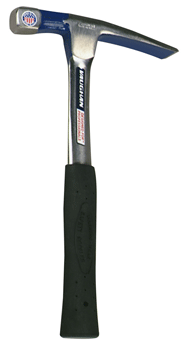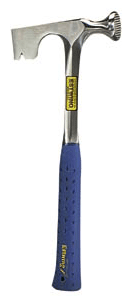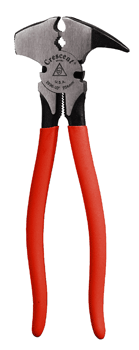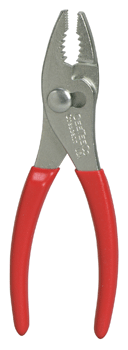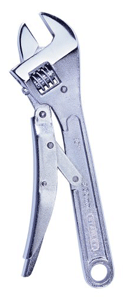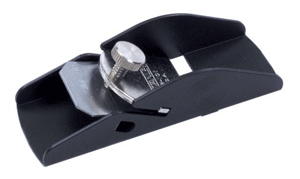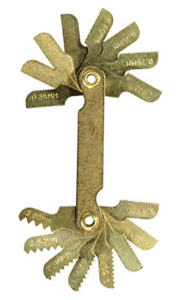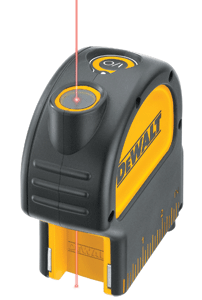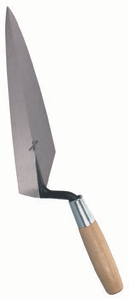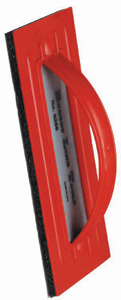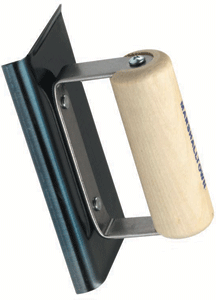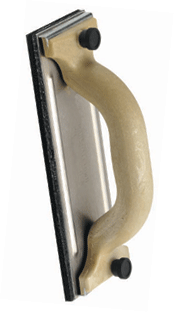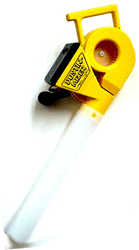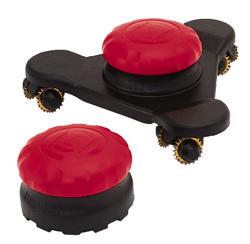DIY Frequently Asked Questions
Hand Tools Terms
Nail Hammer
- Used for general carpentry, household chores and nail pulling.
- Should be used only with non-hardened, common or finishing nails.
- Curved claw offers leverage in removing nails and can also cradle a 2×4.
- Choose 16 or 20 oz. weights for general carpentry; choose 7, 10 and 13 oz. weights for fine cabinetry or light-duty driving.
- Available with smooth or waffled (serrated) faces. Milled face is for finishing jobs while waffled face provides more control when hammering large nails into lumber. Some claw hammers feature a side notch on the head for easier pulling of small nails and fasteners.
Rip Hammer
 Also known as a Rip Hammer
Also known as a Rip Hammer- Used mainly by professionals for ripping apart wooden components and demolition work.
- Should be used only with non-hardened, common or finishing nails.
- Choose weights from 20 to 32 oz. for framing and ripping.
- Available with milled or waffled faces to grip the nail head and reduce the effect of glancing blows and flying nails.
Ball Peen (Ball Pein) Hammer
 Used with cold chisels for riveting, center punching and forming unhardened metal work.
Used with cold chisels for riveting, center punching and forming unhardened metal work.- Striking face diameter should be about 3/8” larger than the diameter of the head of the object being struck.
- Designed with a regular striking face on one end and a rounded or half ball on the other end instead of a claw.
- Sizes range from 2 oz. to 48 oz. with 12 and 16 oz. the most popular.
- Variations include a cross-peen hammer (with horizontal wedge-shaped face) and a straight-peen hammer (with vertical wedge-shaped face).
Mallet
 Has rubber, plastic, wooden or rawhide head.
Has rubber, plastic, wooden or rawhide head.- Used to drive chisels or hammer joints together.
- Sizes are specified in head weight or diameter with the exception of wooden mallets, which are specified by head diameter only.
- Comes in variety of shapes and sizes for specific tasks.
- Carpentry mallet features angled head to reduce fatigue; shop mallet with octagonal head is used for flat strikes; rawhide mallet is used in furniture assembly.
Cutting Pliers
 • Can be side, end or diagonal types.
• Can be side, end or diagonal types.
• Side cutters have a cutting blade on one side only and are available in long-, curved- and short-nose types.
• End cutting nippers have cutting blades on the end and are used to make sharp, clean cuts close to the surface on wires, bolts and rivets.
• Diagonal cutters have two cutting blades set diagonally to the handle. They offer leverage when pulling cotter pins and are used by mechanics and electricians for general cutting.
• Some cutting pliers are made with a spring in the handle to open automatically after each cut.
Linemen’s Pliers
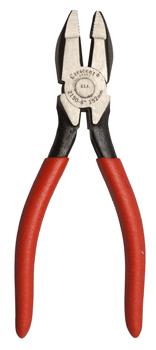 • Also called electrician’s pliers. Used by professionals engaged in electrical, communications and construction work.
• Also called electrician’s pliers. Used by professionals engaged in electrical, communications and construction work.
• Used for cutting, holding, shaping and twisting wire.
• Heavy-duty, side-cutting pliers designed for all regular wire-cutting needs.
• Have gripping jaws in addition to cutting edges.
• High-leverage lineman’s pliers have rivet placed closer to the cutting edges to provide more leverage.
• Two head patterns are available: standard (bevel nose) and round nose, which is more streamlined.
• Sizes range from 6-1/4” to 9-1/4”.
Locking Pliers
 • Adjustable, vise-type locking pliers that can be locked on to a work piece and operate like a clamp.
• Adjustable, vise-type locking pliers that can be locked on to a work piece and operate like a clamp.
• Features an adjustment screw that changes the jaw size to apply the correct clamping pressure.
• Available in various sizes and shapes: curved jaw puts pressure on any style nut or bolt head; curved jaw with wire cutter also allows user to cut wire; straight jaw provides maximum contact on flat, square or hex work; long nose provides easy access in hard-to-reach places; large jaw is used by plumbers, welders and mechanics working with large objects; and bent nose is for work in tight places.
• Some use a mechanism that allows one-handed release; others require two hands to disengage.
• Many locking pliers provide a wire-cutting function, some from a full range, others from a restricted range of jaw settings.
Standard Slotted-Tip Screwdriver
![]() • For driving and removing standard, slotted screws
• For driving and removing standard, slotted screws
• Slots generally range in size from 1/6” to 1/4”.
• Tip is flared at shoulder of blade so it is wider than the driver bar.
• Blades should not taper too sharply from the tip, because an improperly tapered tip has a tendency to rise out of the screw slot.
• Can have a square or round shank.
Phillips® Tip Screwdriver
 Used on cross-slotted screw heads with modified U-shaped slots of uniform width.
Used on cross-slotted screw heads with modified U-shaped slots of uniform width.- Sizes range from 0 to 4, with 0 being the smallest.
- Similar tip configurations include Frearson tips that have cross slots that are V-shaped slots with tapered sides, and Pizidriv® with additional, smaller slots at 45-degree angles to the main cross slots.
Hex Nut Driver
 Similar to a screwdriver, but has a tip like a wrench socket.
Similar to a screwdriver, but has a tip like a wrench socket.- Used mainly on small hex nuts and in confined areas such as electronic equipment, car ignitions and plumbing jobs.
- Available in several sizes and styles, with a fixed-size or variable-size “socket” at the end to adjust to various nut sizes.
Offset Screwdriver
 Designed for removing and inserting screws in places where it is impossible to use a straight shank screwdriver.
Designed for removing and inserting screws in places where it is impossible to use a straight shank screwdriver.- Available in two- or four-blade varieties, with one end slotted and one end Phillips
- Some models available with reversible ratcheting mechanism to turn screw tip and magnetized tips to guide screws into holes or otherwise inaccessible areas.
- Others have split-points that can be expanded in width to fill the screw slot and hold screws when guiding into inaccessible areas. A spring clamp that fits over the screw head, holding the bit in the slot, serves a similar purpose.
Jeweler’s Screwdriver
 Has a rotating head that is held by the forefinger to steady the screwdriver while the thumb and middle finger turn the screwdriver to remove or install small screws.
Has a rotating head that is held by the forefinger to steady the screwdriver while the thumb and middle finger turn the screwdriver to remove or install small screws.- Mainly used by jewelers and hobbyists and others who often work with very small screws.
- Generally manufactured in sizes ranging from .025” to .1”.
- Usually available in sets with Phillips and slotted tips.
Bit Brace
 A hand-drilling tool with a crank handle generally used to drill large holes in wood.
A hand-drilling tool with a crank handle generally used to drill large holes in wood.- Drilling is done by turning the handle or center section in a circular motion. Pressure is applied to the knob or head of the bit brace with the heel and palm of the hand.
- The knob or head of the bit brace is mounted on ball bearings so that it will turn freely from the rest of the brace and remain stationary when turning the tool.
- Generally used with auger bits.
- Can also be used as a powerful screwdriver.
- Direction ratchet control in some models permits turning the bit in one direction and not the other which can be useful in tight spaces.
Hand Drill
 Also called an eggbeater drill, the drilling action comes from turning a hand crank on the side of a drill frame.
Also called an eggbeater drill, the drilling action comes from turning a hand crank on the side of a drill frame.- Features adjustable drill chuck to permit easy changing of drill bits ranging in size from 1/16″ to 1/2″.
- Usually has drill bit storage in handle.
- Generally used for precise drilling in fine woodworking applications.
Awl
 Used to make screw-starting holes for drilling, screwing or nailing when lightly tapped by palm of hand or with hammer or soft-face mallet.
Used to make screw-starting holes for drilling, screwing or nailing when lightly tapped by palm of hand or with hammer or soft-face mallet.- Also used for scribing or scoring along a straight edge to produce a sawing or layout line on wood or soft metal.
- A gimlet is a variation of the awl with threads like a screw on the tip.
Open-End Wrench
 Provides gripping power on two sides of the head with another side open so the wrench can be placed on a nut, which might not be accessible to a closed or box wrench.
Provides gripping power on two sides of the head with another side open so the wrench can be placed on a nut, which might not be accessible to a closed or box wrench.- Has different size openings on each end and should fit the nut exactly to prevent mutilating the nut edges.
- Some types, called flare nut wrenches, are flared to fit hex fittings and flare nuts.
- Generally available in sets.
Combination Wrench
 Has a box and an open end on opposite sides of the same wrench. Both ends are usually the same size.
Has a box and an open end on opposite sides of the same wrench. Both ends are usually the same size.- Used for working on machinery and is the most popular of all fixed-end wrench styles.
- Also available is a reversible ratcheting combination wrench that allows the user to quickly tighten nuts and bolts without lifting the wrench off and repositioning it after each rotation.
Adjustable Wrench
 Comes in two styles: locking and non-locking.
Comes in two styles: locking and non-locking.- Non-locking styles feature an adjustable end opening with little provision made for slippage.
- The locking style also has an adjustable head, but uses a locking mechanism to secure jaws in desired position, eliminating the need for constant readjustment. When properly adjusted to a nut or bolt, it will not slip.
Pipe (Stillson) Wrench
 Screws pipes into elbows or other threaded devices.
Screws pipes into elbows or other threaded devices.- Jaws actually bite into the surface to hold it for turning.
- They should never be used on plated pipe installations because they will badly mar the finish.
- Aluminum pipe wrenches are popular among professionals because of their lighter weight, but they are more expensive.
Socket (Hinge Handle) Wrench
 Combines an offset handle with a male drive piece that has a spring-loaded bearing to lock on various size sockets. They can be used at almost any angle since handles may be attached to the head by a jointed hinge device.
Combines an offset handle with a male drive piece that has a spring-loaded bearing to lock on various size sockets. They can be used at almost any angle since handles may be attached to the head by a jointed hinge device.- The most common type is the detachable socket wrench, with square drive for hand use. Common square drive sizes are 1/4″, 3/8″ and 1/2″, and these are normally used in conjunction with a ratchet wrench.
- Sockets are available with 6-, 8- and 12-point gripping ends, in a full range of inch and metric sizes.
Ratchet (Socket) Wrench
 Available in a variety of handle shapes and lengths and used with sockets to make turning nuts and bolts easier than with a conventional wrench.
Available in a variety of handle shapes and lengths and used with sockets to make turning nuts and bolts easier than with a conventional wrench.- Available in 1/4″, 3/8″ and 1/2″ drive sizes and are used with socket wrenches.
- Available with a round or teardrop-shaped head and contains a reversing mechanism to facilitate tightening or loosening a fastener.
- Popular accessories include flex handles, speeder handles, T-handles, extensions of various lengths and universal joints to work on fasteners in hard-to-reach locations.
Torque Wrench
 Designed to permit an operator to determine applied torque on bolts, nuts and other fasteners.
Designed to permit an operator to determine applied torque on bolts, nuts and other fasteners.- Torque value (generally measured in foot pounds) is set to a micrometer scale on the handle or preset by an adjusting screw in the handle.
- Typically has square drives to use standard detachable 3/8” and 3/4” sockets.
- Available with audible signal (clicking sound) or visual display.
- Many torque wrenches are available with dual scales for conventional and metric measurements.
Chain Wrench
 A pipe wrench used for tightening and loosening odd-shaped objects, such as pipes and square objects.
A pipe wrench used for tightening and loosening odd-shaped objects, such as pipes and square objects.- Has an adjustable chain that wraps around the object, with ends that connect teeth of chain to engage and turn the object.
- Some models feature a locking mechanism with ratcheting action for turning in either direction.
Wood Chisel
 Comes in a variety of sizes and styles. The butt chisel has a short blade that ranges from about 2-1/2″-3″ long. It is used by pattern makers, cabinetmakers, carpenters and do-it-yourselfers for carving and paring, particularly in tight spots. It can be used with hard-faced hammers.
Comes in a variety of sizes and styles. The butt chisel has a short blade that ranges from about 2-1/2″-3″ long. It is used by pattern makers, cabinetmakers, carpenters and do-it-yourselfers for carving and paring, particularly in tight spots. It can be used with hard-faced hammers.- A firmer chisel is square-sided, medium-duty chisel and has a longer blade, usually from 3-1/2″-6″ and is used mainly for cutting deeply into wood. It should be used with soft-faced hammers.
- Paring chisels are for light-duty, detailed work such as trimming cabinets.
Retractable-Blade Utility Knife
 General-use tool designed to cut materials such as drywall, cardboard cartons, laminates and plastic.
General-use tool designed to cut materials such as drywall, cardboard cartons, laminates and plastic.- Blade retracts into body of knife for safer operation and storage.
- Some models have up to 3 different blade positions for different cutting depths.
- Higher-end models have rubber grips and ergonomic designs for better gripping.
- Handle generally unscrews or swivels open to permit blade changes.
- Many models have extra blade storage in handle.
- Some models have spring-loaded blades that automatically retract when the knife is released.
Fixed-Blade Utility Knife
 Blade locks between the halves of the knife to provide more blade stability than retractable models.
Blade locks between the halves of the knife to provide more blade stability than retractable models.- Handle generally unscrews or swivels open to permit blade changes.
- Higher-end models have rubber grips and ergonomic designs for better gripping.
- Unlike retractable knives, accepts larger or special-purpose blades that can’t retract into the handle.
Snap-Blade Knife
 Blade sections snap off (generally between 8 and 13 per blade) without having to open the tool to change blades.
Blade sections snap off (generally between 8 and 13 per blade) without having to open the tool to change blades.- Generally used for cutting light- and medium-duty materials such as wallpaper, rubber, vinyl and leather, or materials with adhesive backing that will stick to the blade and prevent sharp, accurate cutting.
Precision Knife
 A pencil-sized tool used for precision cutting of lightweight materials, such as paper or poster board.
A pencil-sized tool used for precision cutting of lightweight materials, such as paper or poster board.- Also called a hobby knife or X-Acto® knife.
- Ultra-sharp blades made from surgical steel come in a variety of sizes in triangle and curved shapes.
- Contains a built-in chuck to hold and secure blades.
- Some models feature blade storage in the handle.
Bolt Cutters
 Are heavy-duty cutters that cut bolts, threaded rods, cables and other metals from 1/16″ to 5/8″ thick.
Are heavy-duty cutters that cut bolts, threaded rods, cables and other metals from 1/16″ to 5/8″ thick.- Made from drop-forged tool steel and range from 12″ to 36″ long. 24” and 30” are most common.
- The longer cutters have greater strength.
- Special leverage joints allow great pressure to be applied with minimum effort.
- End-cut cutters operate similarly to end-cut pliers, with special jaws available to cut special metals.
Bench Plane
 An adjustable tool used for trimming, beveling, fitting and shaping wood, and smoothing rough spots left by sawing and drilling.
An adjustable tool used for trimming, beveling, fitting and shaping wood, and smoothing rough spots left by sawing and drilling.- Blades are positioned bevel side down at a 45-degree angle.
- Models range in size from 9″ smooth planes to 24″ jointer planes.
- Smooth planes are smaller (generally 9” to 10”) and lightweight and used for flattening and smoothing the face of boards and other all-around work.
- Jack planes are longer (12″ to 17″) and heavier than smooth planes, have more cutting capacity and are used for smoothing and squaring rough lumber surfaces.
- Jointer planes, the longest (approximately 22” to 24” long) and heaviest of planes, are used to shape edges of doors or long boards so two boards may be joined together to make a close fitting joint.
Block Plane
 Is much smaller than bench planes and used for smoothing the end grain of boards and shaping small pieces of wood.
Is much smaller than bench planes and used for smoothing the end grain of boards and shaping small pieces of wood.- Blades are positioned bevel side up and set at a low angle (12 degrees in low angle models and 20 degrees in standard models) to permit very thin shaving of work piece.
- Available in both adjustable and non-adjustable models, adjustable block planes feature steel screws, usually on the end of the plane, to vary the height of the cutting iron.
- Some block planes have an adjustable mouth to vary chip thickness. A very narrow mouth is best for fine finishing, while a wider mouth allows quick stock removal on less critical work.
Surface Forming Plane
 Also called a pocket plane, the blade files away material like a cheese grater.
Also called a pocket plane, the blade files away material like a cheese grater.- Blade design makes them much safer than most cutting tools and easier to use than a conventional plane.
- Used for quick, single-handed trimming and cutting, particularly on drywall and PVC.
- Leaves a rough surface on wood.
- Available in regular, round and half-round patterns.
Rabbet Plane
 Also called a rebate plane.
Also called a rebate plane.- Lightweight tool (generally 4” long) used by cabinetmakers and do-it-yourselfers to cut rectangular recesses (called rabbets or rebates) out of the edges of boards and to make grooves in flat surfaces.
- Has an adjustable mouth for either fine or course work.
- Cutter is positioned at front of plane to enable tool to fit closely into corners
Framing Square
 90 degree L-shaped tool made from one piece of material (steel or aluminum), with the long end (blade) usually 24″ and the short end (tongue) 16″.
90 degree L-shaped tool made from one piece of material (steel or aluminum), with the long end (blade) usually 24″ and the short end (tongue) 16″.- Also known as carpenter’s or rafter square because this tool is generally used for laying out rafters and marking stair stringers.
- Similar squares are also available in other sizes (8″ x 12″).
- Generally has framing tables (rafter and Essex tables) etched into the body to provide information on roof framing.
- Also has ruler increments printed on the inside and outside edges.
Try Square
 An L-shaped tool used as a guide for pencil markings of 90 degree cuts and to check the edges and ends of boards for squareness.
An L-shaped tool used as a guide for pencil markings of 90 degree cuts and to check the edges and ends of boards for squareness.- Also used to determine whether a board is the same depth for its entire length.
- Try squares have broad 6″ to 12″ blades set at right angles, with wood, plastic or metal handles.
- Also available is a try/miter square, which features a 45º corner edge.
Combination Square
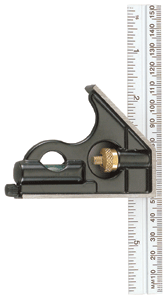 Has a grooved blade and head that can be adjusted (by loosening the thumbscrew) to many locations along the 12” blade to provide different measurements and for scribing.
Has a grooved blade and head that can be adjusted (by loosening the thumbscrew) to many locations along the 12” blade to provide different measurements and for scribing.- One edge of the head (which is usually metal or plastic) has a 90-degree fence for crosscutting while the other has a 45-degree angle for use as a miter square.
- The head also contains one level vial to check for level and plumb and a scratch awl for scribing.
- Some combination square sets are available with an attached protractor that is movable throughout 180º for setting the blade at any angle within that range.
Speed Square
 A small triangle-shaped square with a flanged edge for butting against the edge of a work piece to draw 90-degree or 45-degree angles.
A small triangle-shaped square with a flanged edge for butting against the edge of a work piece to draw 90-degree or 45-degree angles.- It has different angle measurements marked on its surface and edges.
- Also used as a cutting fence for circular power saws.
- Markings on diagonal edge correspond to layout dimensions for rafters and stairs.
- Generally available in 7” and 12” sizes.
Retractable Tape Measure
 Ranges in blade length from 6′ to 35′, with 10’, 16′ and 25′ being common sizes.
Ranges in blade length from 6′ to 35′, with 10’, 16′ and 25′ being common sizes.- The concave blade measuring rule varies in width from 1/4″ to 1-1/4″—wider tapes are easier to extend over longer distances without collapsing.
- A spring mechanism contained in the housing automatically retracts the tape.
- A locking mechanism locks the tape in place. Some models have buttons that slide to lock the blade, while others have levers and toggles that permit the tape to retract when squeezed.
- Many have markings for laying out studs on 16″ centers or other specialized markings.
Digital Tape Measure
 Similar to a conventional tape measure but with electronic features added, such as a digital readout to make measurement readings more precise and the ability to convert fractions to decimals or even metric equivalents.
Similar to a conventional tape measure but with electronic features added, such as a digital readout to make measurement readings more precise and the ability to convert fractions to decimals or even metric equivalents.- Another useful feature is a function that compensates for the size of the tape case when taking inside measurements, such as a window frame or a door jamb.
- Some models have a memory function which holds a measurement without having to write it down. Other models have a voice recorder to make it easy to keep track of multiple measurements.
Folding Rule
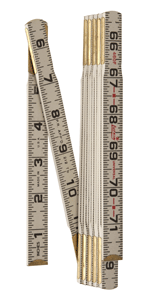 Measuring device consisting of 6″ to 8″ hardwood, steel or aluminum lengths connected by spring joints that unfold for measuring distances.
Measuring device consisting of 6″ to 8″ hardwood, steel or aluminum lengths connected by spring joints that unfold for measuring distances.- Some models include an extension slide for measuring closed-in areas such as doorways and window frames where a regular folding rule will not work. The rule is unfolded as far as possible, then the slide is extended and its measurement added to the overall measurement for a total measurement reading.
- Different models are designed for specific measuring needs of masons, engineers, carpenters and plumbers.
Measuring Wheel
 Consists of a wheel, handle and odometer designed for lengthy exterior measurements—up to 10,000 feet.
Consists of a wheel, handle and odometer designed for lengthy exterior measurements—up to 10,000 feet.- Features include collapsible or telescoping handles, gear-driven counters, a variety of wheel sizes, different types of tread materials and optional carrying cases.
- A push button reset returns the counter to zero.
- Wheel diameters range from 4” to 25”, with professionals generally opting for the large-wheeled units that are suitable for rough terrain.
Calipers
 Tool consisting of two curved pieces of metal that are joined at one end with a pivot that has a screw to adjust the distance between the two pieces.
Tool consisting of two curved pieces of metal that are joined at one end with a pivot that has a screw to adjust the distance between the two pieces.- Used for transferring measurements from a model or prototype to a part being produced.
- Can also be used to measure the inside or outside of holes or objects that cannot be reached easily with a graduated measuring device.
- Common models include inside and outside calipers.
Dial Calipers
 Tool used for measuring inside and outside diameters of cylinder-shaped objects, such as drill bits and pipe.
Tool used for measuring inside and outside diameters of cylinder-shaped objects, such as drill bits and pipe.- Dial readout provides accurate measurements in 1/64” or .01”.
- Metric models are also available.
- Other models include vernier calipers, which don’t have a dial and require the user to read from measurements on linear scale, and electronic digital calipers, which have a digital display readout.
Stud Finder
 Stud finders are devices that help locate wall studs, enabling you to hang pictures, mirrors and shelves securely.
Stud finders are devices that help locate wall studs, enabling you to hang pictures, mirrors and shelves securely.- Come in two basic types—electronic, which finds the stud by measuring the density of the wall, and magnetic, which detects nails and/or metal studs in the wall.
- In addition to wood and metal studs, some advanced electronic stud finders will locate pipe, conduit, electrical wires and even reinforcing bar buried up to 6” in concrete.
Carpenter’s Level
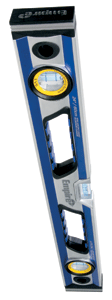 Tool that employs bubble vials positioned in the center and both ends to check vertical and horizontal surfaces for level or plumb.
Tool that employs bubble vials positioned in the center and both ends to check vertical and horizontal surfaces for level or plumb.- Made of either hardwood with brass binding, metal (aluminum, magnesium) or high-impact plastic.
- Typically 24″ to 48″ long, but some models (generally mason’s levels) are longer and can be up to 72” in length.
- Some models include split level or graduated vials that have two sets of lines, with the outside line representing a 2 percent grade that conforms to the slope required for gutters and waste lines to drain properly.
- Some models include electronic features to calculate angles on sloped surfaces (roof pitches, stair slopes and drainage angles) and display reading in degrees, percent slope or inches per feet (rise/run).
Torpedo Level
 • Usually 9″ long and 1” wide, it is used for obtaining readings in close quarters where a typical carpenter’s level won’t fit.
• Usually 9″ long and 1” wide, it is used for obtaining readings in close quarters where a typical carpenter’s level won’t fit.
• Because of its compact size, mechanics, plumbers, electricians, hobbyists and homeowners often choose torpedo levels.
• Enhancement features include magnetized models and models incorporating a battery-operated light for working in dark areas.
Laser Level
 Also called laser chalk lines, they are used to level and provide reference lines for hanging pictures, tile work, etc.
Also called laser chalk lines, they are used to level and provide reference lines for hanging pictures, tile work, etc.- New features for electronic levels include having preset angles commonly used in construction, a self-leveling feature, and offering a graphical display that tells the user the direction and extent to rotate toward level or plumb.
- Accessories include a variety of mounting devices such as clamps and magnetic mounts that make setup and use easier and more convenient.
Single-Bit Axe
 Most popular style of axe, the single-bit axe is used to fell, trim or prune trees, to split or cut wood.
Most popular style of axe, the single-bit axe is used to fell, trim or prune trees, to split or cut wood.- The easiest and safest axe for inexperienced woodcutters to use because it only has one cutting edge.
- The other end of the head, the poll, forms a hammer for driving wooden or plastic stakes. It should never be used to strike splitting wedges, steel posts, stone or any hard object.
- Handles for single-bit axes are curved to help increase leverage. Axe handles are made of hickory and range from 20″ to 36″ long. The most common is 36″.
- Common head patterns include Michigan, Dayton, Kentucky, Connecticut and New Jersey.
Double-Bit Axe
 Performs the same function as single-bit axe, but has two cutting edges—one on each end of the head.
Performs the same function as single-bit axe, but has two cutting edges—one on each end of the head.- Generally used by professional lumbermen.
- Double-bit axes have straight handles because the handle must be symmetrical with the double-edge head.
- Common head patterns include Western, Michigan, Swamping and Reversible.
Shingling Hatchet
 Generally used for installing wood shakes and shingles made of wood, fiberglass and composition.
Generally used for installing wood shakes and shingles made of wood, fiberglass and composition.- Some models have a replaceable adjustable gauge that helps installer determine the exposed length of a shingle.
- Many models also include nail slots and draw knives built into the head.
- Handles can be made of hickory, fiberglass, tubular steel or solid steel.
Splitting Wedge
 Tool used to finish splitting wood when struck with splitting maul after a starting notch is made.
Tool used to finish splitting wood when struck with splitting maul after a starting notch is made.- Made of steel, aluminum and plastic.
- Steel wedges are forged from a solid piece of high-carbon steel and may be heat-treated.
- Aluminum and plastic wedges are designed primarily for use with chain saws and crosscut saws to hold the kerf apart to prevent binding.
- Wedges should be struck with a sledge or woodchopper’s maul having a larger striking face than the head of the wedge.
- Never strike the steel wedge with the cutting edge of the maul.
Rip Saw
 Has large, chisel-shaped teeth, usually 5-1/2 teeth per inch, and is made to cut with the wood grain.
Has large, chisel-shaped teeth, usually 5-1/2 teeth per inch, and is made to cut with the wood grain.- Blade lengths measure from 24″ to 28″. • Teeth are cross-filed to ensure that the chisel point is set square to the direction of cutting for best performance.
- This saw is best held at a 60º angle to the surface of the board being cut. The ripping action of the saw produces a coarse, ragged cut that makes the saw unsatisfactory for finish work.
Crosscut Saw
 Designed for cutting across wood grain and produces a smoother cut than rip saws.
Designed for cutting across wood grain and produces a smoother cut than rip saws.- Has teeth shaped like knife points to crumble out wood between cuts.
- The most commonly used crosscut saws are 10- to 12-point for fine work and 7- or 8-point for faster cutting. 10 teeth per inch is considered general purpose
- Blade lengths range from 20″ to 28″, with 26″ the most popular.
- Can also be used to cut plywood.
- Best cutting angle for this saw is about 45º.
Hacksaw
 Is a fine-toothed saw designed to cut metal or plastic. Hacksaws consist of a blade held in a steel frame with relatively high tension to hold the blade rigidly straight. High-tension models (with tension to 32,000 p.s.i.) are also available.
Is a fine-toothed saw designed to cut metal or plastic. Hacksaws consist of a blade held in a steel frame with relatively high tension to hold the blade rigidly straight. High-tension models (with tension to 32,000 p.s.i.) are also available.- Blades come in coarse-, medium (18 tpi), fine (24 teeth per inch and very fine-toothed (32 tpi). Regular or standard blades are used for general-purpose cutting; high-speed or bi-metal blades for cutting hard, extra-tough steel.
- Most models can be adjusted to hold various blade lengths. Some have both horizontal and vertical positions for blades. Others provide blade storage.
- A close-quarter (or utility) hacksaw holds and positions a hacksaw blade so it can be used effectively in narrow spaces and slots.
- Replacement blades include rod saw blades capable of cutting through most hard materials—spring and stainless steel, chain, brick, glass and tile.
Compass or Keyhole Saw
 Cuts curved or straight-sided holes.
Cuts curved or straight-sided holes.- Saw blades are narrow, tapered nearly to a point to fit into most spaces.
- Blades come in three or four styles that can be changed to fit the job.
- Some models have induction-hardened teeth for longer life without sharpening.
- Keyhole saws are small compass saws with finer teeth that can cut metal.
- Turret head keyhole blades can be rotated and locked in several positions for easier cutting in tight, awkward spots.
Bow Saw
 Consists of a tubular steel frame and a saw blade for fast cutting of all woods.
Consists of a tubular steel frame and a saw blade for fast cutting of all woods.- The bow saw’s frame is important, since the thin blade, usually 3/4″ wide, must be held under high tension for fast cutting.
- Advantages of this general-purpose saw are its all-around utility and light weight.
- Some bow saws are designed to hold hacksaw blades as well as standard bow saw blades. These multi-purpose saws can be used to cut wood, metal or plastic.
Plywood Saw
 Is specially designed for sawing plywood, veneers, laminates and moldings.
Is specially designed for sawing plywood, veneers, laminates and moldings.- The blade, which cuts on the push stroke, is curved downward at the end to allow user to start cuts in the center of a board.
- Not designed for cutting solid wood.
- Standard saw lengths are 12″-13″, generally with 14 teeth per inch.
Pull Saw
 Is similar to most traditional saws except the teeth are designed to cut with a pulling motion.
Is similar to most traditional saws except the teeth are designed to cut with a pulling motion.- Pull saws cut wood faster and with less effort because of the thinner and more flexible blade.
- The saws feature teeth diamond-ground on three cutting edges.
- Because of the flexibility of the blade and the minimal set to the teeth, the saws are excellent for flush cutting.
- Mini pull saws that cut sharply on the pull stroke are used for precision carpentry.
Miter Box
 Used to help cut exact angles for wood trim and rafters.
Used to help cut exact angles for wood trim and rafters.- Better models provide a mechanism for a backsaw.
- They are made of plastic, hardwood or aluminum.
- Some boxes feature magnetic mount guides. The magnets grasp and hold the saw to the miter box saw guide or hold the saw blade to the plane of the saw guide.
C-Clamp
 The most common type of clamp—consists of a C-shaped frame, made of either forged steel or cast iron, into which an adjustable screw is assembled to change the jaw opening.
The most common type of clamp—consists of a C-shaped frame, made of either forged steel or cast iron, into which an adjustable screw is assembled to change the jaw opening.- The size of a C-clamp is measured by its jaw capacity—the dimension of the largest object the frame can accommodate with the screw fully extended. Most range in jaw capacity from 2” to 10”.
- Also important is depth of throat, the distance from the center line of the screw to the inside edge of the frame. C-clamps range from 3/4″ to 14″.
- Most have a sliding cross-pin handle or a wing nut that is used to tighten the screw.
Bar Clamp
 Has a clamping device built on a flat bar, which is usually made of steel.
Has a clamping device built on a flat bar, which is usually made of steel.- The length of the bar determines the capacity of the clamp, which is the dimension of the largest object that can be accommodated between its clamping jaws.
- “Reach” is the distance from the edge of the bar to the end of the clamping jaws.
- Screw pressure applies the final clamping load.
- Bar clamps are used for clamping large objects, making them popular with woodworkers and hobbyists.
One-Handed Bar Clamp
 These are bar clamps designed with a pistol grip to allow the user to tighten or loosen the clamp instead of screwing it.
These are bar clamps designed with a pistol grip to allow the user to tighten or loosen the clamp instead of screwing it.- Can be adjusted by using just one hand on a trigger switch.
- Perhaps the most significant innovation to come about recently in the area of clamps.
- Available in jaw openings from 6″ to 50″ and a variety of sizes
Pipe Clamp
 Can be mounted to standard threaded or unthreaded pipe to clamp boards together while gluing.
Can be mounted to standard threaded or unthreaded pipe to clamp boards together while gluing.- Clamping can be performed from one end or both, and jaws can be positioned at the ends or anywhere along the pipe.
- Pipe clamps can also be quickly converted from a clamp to a spreader.
- A hardened steel set screw holds the head firmly on the pipe, but is easily loosened. The 3/4″ size has a crank handle, and depth from screw center to pipe is 11/16″. The 1/2″ size has a crosspin handle, with depth from screw center to pipe of 7/8″.
Handscrew Clamp
 Also called a cabinetmaker’s clamp, it consists of two hardwood clamping jaws adjusted to the work by two opposing steel screw spindles assembled into the jaws.
Also called a cabinetmaker’s clamp, it consists of two hardwood clamping jaws adjusted to the work by two opposing steel screw spindles assembled into the jaws.- The jaws adjust to a variety of angles and come in a wide range of sizes up to 10”.
- They are used for clamping wood, metal, plastic and fabrics.
- Handscrew adaptors can be used to convert handscrews into miter clamps.
- Also available are handscrew kits so woodworkers can make their own jaws.
Spring Clamp
 Similar to a clothes pin, this clamp consists of two metal jaws to which clamping pressure is applied by use of a steel spring.
Similar to a clothes pin, this clamp consists of two metal jaws to which clamping pressure is applied by use of a steel spring.- They are designed for use with thin materials.
- Spring clamps are versatile enough for home, hobby or professional use indoors or outdoors, holding round or odd-shaped objects.
- They typically come with 1″, 2″ or 3″ jaw openings.
Bench Vise
 Tool that mounts on a workbench or table to hold work pieces securely in place between two flat jaws.
Tool that mounts on a workbench or table to hold work pieces securely in place between two flat jaws.- Generally used in light-duty applications.
- Available in both stationary and swivel models to hold work at various angles and positions.
- A threaded spindle opens and closes the jaws of the vise to hold and release work piece.
- Generally has jaws ranging in length from 3″ to 8″.
- Jaw opening ranges from 4” to 12” in different models.
Woodworking Vise
 Has jaws made of wooden pads to hold work piece securely in place without marring surface of work piece.
Has jaws made of wooden pads to hold work piece securely in place without marring surface of work piece.- Generally mounted to the side of a workbench
- Some woodworking vises have a fast-acting screw arrangement for the rapid positioning of the movable jaw prior to clamping.
- Smaller vises have continuous screws and are light and easy to clamp on a workbench or sawhorse.
Utility Vise
 Similar to a bench vise.
Similar to a bench vise.- Generally has jaws ranging in length from 3″ to 6″.
- Better models feature swivel bases so the vise may be turned to the best angle for each particular job.
- Some utility vises either have cast-in pipe jaws or permit special curved-face pipe jaws to be inserted between the regular jaws to add versatility.
Staple Gun
 Also called manual power staplers, this tool shoots a variety of staples (and many times brad nails) with a one-hand lever operation.
Also called manual power staplers, this tool shoots a variety of staples (and many times brad nails) with a one-hand lever operation.- Good for a variety of jobs requiring material to be held with one hand and fastened with the other, such as lining closets, installing insulation, tacking ceiling tile or fastening roofing paper.
- One new design features a handle that is squeezed toward the front instead of the rear, making it easier to use and control.
- Other models are designed to fasten a variety of materials, such as different types of wire, including telephone wire, heavy-duty wire and insulated wire, etc.
- Electric and cordless staple guns are also available. They have the same uses as the hand-operated guns but the staples are ejected automatically with the pull of a trigger.
Hammer Tacker
 Also called a “slap tacker,” this tool resembles a hammer in design, with the stapling mechanism in the head and the staples stored in the handle.
Also called a “slap tacker,” this tool resembles a hammer in design, with the stapling mechanism in the head and the staples stored in the handle.- The unit is used like a hammer and automatically drives a staple with each blow.
- Commonly used by construction crews to install roll felt roofing paper under roofing materials.
Glue Gun
 Electrically operated glue guns consist of a heating element, nozzle and glue chamber.
Electrically operated glue guns consist of a heating element, nozzle and glue chamber.- Glue or caulking sticks are put in the chamber, where they are melted by heat and released through the nozzle. The adhesive cures by cooling. Cordless models are also available.
- Some models require the operator to maintain pressure on the glue stick with the thumb. Others are self-feeding. The trigger mechanism on some models closes the nozzle to prevent dripping.
- There are a variety of glues available—both with a gun and in replacement packages including heavy-duty types for wood joints requiring about 60 seconds drying time and lightweight for paper, etc., with shorter drying time.
Rivet Tool
 Plier-type tool that fastens materials together using rivets. The tool flattens the rivet heads to create a flange that sandwiches the material together.
Plier-type tool that fastens materials together using rivets. The tool flattens the rivet heads to create a flange that sandwiches the material together.- Can be used in place of screws, nails and other fasteners in many applications, such as thin metal, leather and canvas.
- It is usually purchased in a set containing one or two interchangeable nosepieces that set 1/8″ steel or aluminum rivets or 3/16″ aluminum rivets. Fixed nosepiece models are only capable of setting 1/8″ steel or aluminum rivets.
- Many rivet tools feature self-storage of the extra nosepieces. Other features include sliding latches to lock handles closed for storage, spring opening handles to make constant usage easy and epoxy finishes to protect the tool.
Tool Box
 Is available in a variety of configurations and made from a variety of materials, with steel being the most popular.
Is available in a variety of configurations and made from a variety of materials, with steel being the most popular.- Plastic toolboxes are available in a number of styles as well. Some are suited for light-duty use, while others are comparable to steel in quality.
- The highest quality plastic boxes are constructed of polypropylene, and some models can hold up to 75 lbs. of tools.
- Some carpenters and precision tool users use hardwood chests because the wood absorbs rust-producing condensation.
- Carpenters’ toolboxes are specially designed so carpenters can carry hand saws and framing squares in the same box with other tools.
Work Belt
 Is generally constructed of leather or nylon and has compartments to keep tools and fasteners organized.
Is generally constructed of leather or nylon and has compartments to keep tools and fasteners organized.- Can be purchased as a single unit that comes complete with a belt and separate compartments and pouches for various tools, or as individual components with the belt and pouches sold separately.
- Most work belts come equipped with a steel or leather hammer loop, a tape measure compartment or clip, and various nail pouches as well as individual compartments for tools and fasteners.
- Belts generally fit waist sizes from 29” to 46” and even 52” and are constructed of leather or padded nylon for comfort.
- Some come equipped with compartments for cell phones.
Wrecking Bar
 Also known as ripping bars or crowbars, these tools are used in construction, demolition and where pulling nails, ripping wood and similar tasks are done.
Also known as ripping bars or crowbars, these tools are used in construction, demolition and where pulling nails, ripping wood and similar tasks are done.- Those with curved ends are also known as gooseneck bars.
- Because of their length, usually 24″ or 30″, they have more leverage than hammers, enabling them to pull much larger and longer nails.
Pry Bar
 Smaller and flatter than a wrecking bar and not designed for heavy-duty prying.
Smaller and flatter than a wrecking bar and not designed for heavy-duty prying.- Features beveled notches in each chisel-like end and ranges in size from 6″ to 21″.
- Useful for removing nails with exposed heads and for prying paneling or molding without marring the surface.
- One type of pry bar features an extra curve, which makes it useful for lifting and holding such things as drywall panels in place.
- Double claw models provide equal force on push or pull.
Nail Set
 Used to countersink nails before filling with putty, plastic, wood or other filling materials for a smooth surface.
Used to countersink nails before filling with putty, plastic, wood or other filling materials for a smooth surface.- Nail sets are sized by 1/32″ and range from 1/32″ to 5/32″.
- It is important that the correct size set be used for each size nail to prevent enlarging of a small nail hole by too large a set.
- The pointed end of the nail set should be cupped or hollowed out to avoid splitting the nail head. Self-centering nail sets are available.
Pointing Trowel
 Used by bricklayers for pointing up their work.
Used by bricklayers for pointing up their work.- Pointing and margin trowels are used for patch work and for cleaning other tools.
- High-quality pointing and margin trowels are forged in one piece and constructed the same as a brick trowel.
- The length of pointing trowels may be from 4-1/2″ to 7″. Best sellers are the 5″ and 6″ lengths.
- A 5″ x 2″ is the most popular margin trowel size.
Concrete Trowel
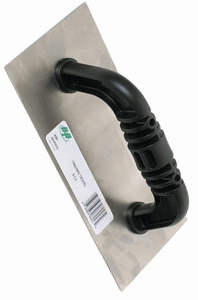 Also called a finishing trowel, this tool is used to compact and finish the surface of the concrete to the required smoothness.
Also called a finishing trowel, this tool is used to compact and finish the surface of the concrete to the required smoothness.- Concrete trowels are narrower and longer than plastering trowels.
- The blade is slightly convex.
- Blades range in width from 3″-5″ and in length from 11″-20″. Most popular sizes are 14″ x 4″ and 16″ x 4″.
Flat File
 Rectangular-shaped file with a single set of teeth used for general sharpening of metal objects.
Rectangular-shaped file with a single set of teeth used for general sharpening of metal objects.- Common types include mill, flat and hand, depending on thickness and the taper.
- A flat double-cut file is commonly used to sharpen mower and axe blades where a mill bastard file is commonly used to sharpen shovel blades.
- A hand single-cut file is used for more precise smoothing and for deburring metal and plastic.
Chain Saw File
 Is made for both round-hooded and square-hooded chain saw teeth.
Is made for both round-hooded and square-hooded chain saw teeth.- For round hooded teeth, the file must be held level against the bevel of the cutting surface of the tooth at an angle of 25° to 45° with the saw blade.
- File direction is off the cutting edge, pressing back and slightly up during the stroke.
Sharpening Stone
 Available in diamond, oiled and dry models, these tools are used to sharpen various blades of cutting tools.
Available in diamond, oiled and dry models, these tools are used to sharpen various blades of cutting tools.- Diamond whetstones sharpen using the diamond dust from the stone.
- Oil stones must be oiled to avoid accumulation of the metal particles from the tools being sharpened. To oil the stone, put a drop or two or lightweight household oil on the stone before each use. Also, new stones should be soaked in a bath of oil for several days before use.
- Flat whetstones are the most common type of oil stones with both a smooth side and a coarse side for various sharpening requirements.
- Drystones wear out much faster than oil stones because the stone’s surface crumbles away when sharpening.
- Be sure to study manufacturer literature to recommend proper stones for different types of blades.
Drywall Taping Knife
 Is used for taping drywall joints and spreading drywall joint compound between wallboard seams.
Is used for taping drywall joints and spreading drywall joint compound between wallboard seams.- Tempered stainless steel blades bow for feathering.
- It can be used in covering nail spots and other indentations in the board as well.
- Blades range in size from 4” to 14”, with the most popular blade widths being 8” and 10”.
- Handles are constructed of either wood, plastic or ergonomic foam rubber for added comfort.
Drywall Finishing Trowel
 Designed for smoothing the various layers of joint compound when finishing drywall.
Designed for smoothing the various layers of joint compound when finishing drywall.- Has a slight concave bow in the blade that helps to feather mud when making drywall joints.
- The tempered, flexible steel blade is securely attached to a lightweight aluminum mounting.
- Handle varieties include smoothly turned basswood handle and ergonomic plastic.
- The most popular size is 11″ x 4-1/2″.
Drywall Pole Sander
 Is used for sanding drywall joints, especially ceilings and side walls without having to use a ladder or stilts.
Is used for sanding drywall joints, especially ceilings and side walls without having to use a ladder or stilts.- Swiveling head design allows for excellent maneuverability and easy access into corners.
- Some models feature a hammerhead tip to easily set drywall nails.
- Sandpaper or sanding screens clamp to head.
- Extension pole is often sold separately.
Mud Pan
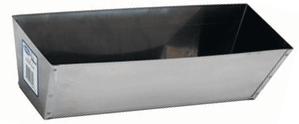 Pan for holding drywall joint compound in hand during application process.
Pan for holding drywall joint compound in hand during application process.- Generally 12” in length with tapered sides for easily applying joint compound onto taping knife.
- Plastic models generally have a replaceable scraping bar for cleaning excess joint compound from taping knives and trowels.
- Galvanized steel models feature watertight seams and sheared sides.
Bow Head Garden Rake
 Rake head is attached to the handle with a long, curved bows extending from each end of the head.
Rake head is attached to the handle with a long, curved bows extending from each end of the head.- Handles are usually 48” to 54” long.
- Used to break up and smooth soil after it has been spaded and cultivated.
- Has sharp, curved steel teeth to pulverize dirt clods.
- The straight back is good for leveling the soil for planting.
Thatching Rake
 Used to remove thatch and dead grass from the lawn.
Used to remove thatch and dead grass from the lawn.- Pointed on one side for pulling and rounded on the other for pushing.
- The wheeled version rolls along the ground. It digs as it is pushed forward and cleans itself of debris as it is pulled backwards.
- The half-moon version does not have wheels. The user drags it along the ground. The pull stroke digs up the thatch, while the push stroke cleans.
Hand Truck
 Also known as a dollie.
Also known as a dollie.- Use to haul trash cans, packages, firewood, etc.
- Capacity ranges from 100 to 400 lbs., depending on the model.
- Has either a solid metal toe plate or tubular shape to support the load.
- Handle styles include pin, safety, continuous or upright.
- Variations include a bag truck. It performs the same task as a hand truck but also incorporates a hoop to hold plastic trash bags with an elastic cord encircling the hoop. The hoop attaches to the frame to hold varying sizes of lawn bags.
Compression Sprayer
 Most popular type of sprayer.
Most popular type of sprayer.- Also known as a pump sprayer or pressure sprayer.
- When the sprayer is pumped, air pressure builds in the tank and forces the spray material through the hose, valve, wand and nozzle.
- The nozzle adjusts spray pattern and the wand facilitates spraying under leaves and other hard-to-reach places.
- Can be carried by hand, over the shoulder or mounted on a caddy.
- Do not use galvanized steel sprayers for strong acidic solutions.
- Plastic sprayers resist corrosion, are lightweight and easy to handle.
- Typically available in 1- to 5-gallon capacities.
Hose-End Sprayer
 Plastic or glass container with a spray nozzle.
Plastic or glass container with a spray nozzle.- Attaches to the end of a hose.
- Best for jobs such as foliage feeding or applying fertilizers, insecticides or fungicides to lawns or gardens where large volumes are needed.
- Spray pattern is normally a wide fan for lawns.
- Uses a special attachment to prevent drift when spraying herbicides.
- Comes with an anti-siphon backflow protector to prevent harmful chemicals from backing up into the water supply.
Knapsack Sprayer
 Carried on the user’s back.
Carried on the user’s back.- Used mostly for commercial applications.
- Made of either polyethylene or metal.
- Operates similar to a compressed air sprayer, but can handle a larger capacity.
- Steady pumping maintains a constant pressure, which produces a uniform discharge rate and spray pattern. Some models only require intermittent pumping.
- Capacity ranges from 3-1/2 to 5 gallons.
Hand Sprayer
 One type produces a fine, floating spray suited for controlling insects.
One type produces a fine, floating spray suited for controlling insects.- Another type produces a wetter, heavier spray for treating exposed surfaces where insects feed, lodge or crawl.
- Another model, a plant mister, produces mist for indoor plants.
- Features intermittent, continuous or hydraulic pressure pumping action.
Power Sprayer
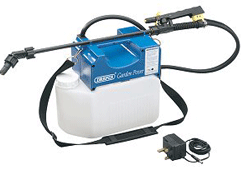 Powered by a gasoline or electric motor to assure greater application efficiency.
Powered by a gasoline or electric motor to assure greater application efficiency.- Tank is large enough to cover large areas with one filling.
- Some models can be towed by garden tractors.
- Used on shrubs, flowers, vegetables and trees.
- Cordless electric models with 1- to 5-gallon tanks eliminate the work of pumping while spraying.
Cotton Gloves
 General-purpose glove for performing a variety of tasks around the home and garden.
General-purpose glove for performing a variety of tasks around the home and garden.- Offers good comfort and breathability.
- Quilted style is good for heavy, multi-purpose applications and added heat protection.
- Chore gloves are for general purpose work.
- Some gloves may be marketed for specific tasks, such as garden gloves with patterns or designs to attract certain types of buyers.
- May be cotton or cotton/polyester blend, canvas, jersey or terrycloth. Often has a knit wrist.
- Some styles may have PVC dots to improve gripping ability and durability.
Leather Gloves
 May be solid leather for heavy-duty applications or have a leather palm.
May be solid leather for heavy-duty applications or have a leather palm.- Durable and long lasting glove. Handles a wide variety of applications.
- Construction materials include cowskin, pigskin, goatskin and deerskin.
- Driving gloves offer dexterity when operating equipment.
- Welding gloves offer protection from heat and sparks in welding applications.
- Gunn pattern leather palm gloves offer protection from rough objects, sparks and for cushioning blows.
- Clute pattern leather palm gloves offer the best economy in leather protection.
Supported Gloves
 Protects against solvents and resists chemicals, cuts punctures and abrasions.
Protects against solvents and resists chemicals, cuts punctures and abrasions.- May be constructed of neoprene, nitrile, PVC, rubber or vinyl.
- One style is a coating over a lining of cotton or other fabric. The fabric helps insulate and adds comfort.
- Another style is dipped, where the PVC or other material does not have a fabric lining.
- Neoprene offers the most chemical protection and flexibility.
- Nitrile offers good abrasion resistance.
- PVC offers good liquid and solvent protection.
- Rubber offers good gripping power and cut and puncture resistance.
- Vinyl offers breathability, gripping power and minimizes absorption.
Vinyl Patching Kit
 Contains a patching material that forms a permanent patch over holes, tears, etc., in vinyl.
Contains a patching material that forms a permanent patch over holes, tears, etc., in vinyl.- Some kits require heat, while other patching material cures in air and requires no heat.
- Also included in these kits is an assortment of “graining paper,” used to reproduce any design in the vinyl.
- With a backing behind the hole in the vinyl, patching material is brushed over the hole and proper graining paper is laid over the patch.
- With material that requires heat, an iron is then pressed over the graining paper to apply the proper heat to the patching material, causing it to take on the pattern of the vinyl and to set properly.
- An assortment of touch-up colors is available to blend the patch into the color of the vinyl.
Fiberglass Repair Kit
 Contains fiberglass fabric for patching and waterproofing.
Contains fiberglass fabric for patching and waterproofing.- It remains flexible after application, preventing reappearance of the same crack.
- Kits includes fiberglass tape and oil-based mastic.
- After the tape is applied over the crack, the mastic is brushed over the tape.
- The edges are then feathered to blend with the surface being repaired.
- Recommended for repairing rain gutters, roofing, interior walls and wood surfaces.
Heat Gun
 Aids in removal of paint and varnish, as well as flooring, adhesives and frozen nuts and bolts.
Aids in removal of paint and varnish, as well as flooring, adhesives and frozen nuts and bolts.- Either comes in one setting (generally 750 degrees F or variable heat settings ranging from 200 degrees F to 1,100 degrees F.
- Higher heat settings are for removing paint and varnish.
- Lower heat settings are for removing flooring, adhesives and bending or molding plastics.
- Resembles a hair dryer.
Caulk Gun
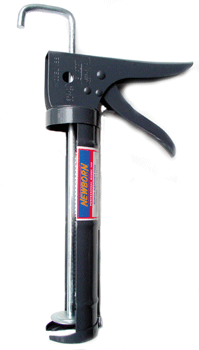 Tool that applies caulk from cartridges to work area.
Tool that applies caulk from cartridges to work area.- Ratchet Guns are less expensive, but are more difficult to use. To stop caulk flow on the ratchet gun, the user must turn the piston so the ratchet disengages.
- Smooth Rod Guns are more expensive, but are easier to use. With a smooth rod gun, the user simply disengages a quick-release thumb plate to stop the flow of caulk. Drip-free smooth rod caulking guns allow the piston to back up slightly after each squeeze so the user does not have to turn the piston or depress a lever to stop the flow of caulk.
- Some models use an automatic vacuum action to draw any unused caulk back into the nose of the tube.
- Power Guns that operate with a rechargeable battery pack are becoming popular with pros and serious d-i-yers.
Sandpaper
 Comes in five general types, including garnet, emery, aluminum oxide, silicon carbide and alumina zirconia. Of these, the first two are natural minerals or abrasives; the others are synthetic materials that are tougher and longer wearing than the natural abrasives.
Comes in five general types, including garnet, emery, aluminum oxide, silicon carbide and alumina zirconia. Of these, the first two are natural minerals or abrasives; the others are synthetic materials that are tougher and longer wearing than the natural abrasives.- All U.S.-manufactured sandpapers conform to the same numerical system for grading coarseness. The smaller the number, the coarser the grit.
- Coarseness generally runs from 12 (extra coarse) to 1500 (ultra-fine). Grit finer than 600 is usually measured on the European FEPA scale, and identified with a “P” immediately before the number.
- The back of each sandpaper sheet contains important labeling information, including product and lot number, abrasive type, grit size, whether it is open or closed coat and backing. The backing weight is rated by letter. “A” is the thinnest weight, while “C” and “D” are the best options for hand sanding of wood. “X” is effective for heavy-duty sanding.
- Manufactured on a variety of backings, including paper, cloth and fiber.
- Garnet is a reddish-brown natural abrasive. By special heat treatment, a tougher, sturdier grain is produced. Garnet is used almost exclusively in the woodworking field; it is not suitable for use on metal.
- Emery is a black natural abrasive that can polish metal surfaces. Emery is typically used in conjunction with an oil lubricant.
- Aluminum oxide is the most common general abrasive. It is a synthetic brown that is hard and long-wearing. It is used on wood, metal or painted surfaces and is well suited to finishing high-tensile materials such as steels and bronzes, as well as some hardwoods.
- Silicon carbide is hard and sharp—effective in sanding low-tensile materials such as cast iron, aluminum, copper or plastic. It is also useful between coats of finish.
- Alumina zirconia is harder than silicon carbide and tougher than aluminum oxide. It should be used for grinding and shaping metal and wood—not for polishing.
- Sandpaper comes in two styles: open coat (OC) and closed coat. “Coat” refers to how densely the grain is adhered to the surface. “Closed coat” means 100 percent of the surface is covered with grain. Open-coat sandpaper has greater spacing between the grains, which prevents it from clogging up as quickly with sanding residue. Closed-coat sandpaper, however, fills more rapidly with the substance being sanded and must be discarded sooner.
- Many styles available in sheets as well as sizes for various sanding power tools.
Steel Wool
 A popular accessory item. It should be used before painting on any glossy surface.
A popular accessory item. It should be used before painting on any glossy surface.- Uses include removing grime and sludge prior to refinishing, preparing new surfaces, removing old coatings on raw wood and for application in between coats of enamel, paint, shellac or varnish.
- Also removes paint from glass, furniture, tile and other surfaces.
- Comes in grades ranging from fine to coarse.
- More water-based strippers and finishes have led to a man-made synthetic steel wool product. This product will not cause spotting in wood, as standard steel wool can when used with water-based finishes.
- Bronze wool is a popular alternative to steel wool.
Wallpaper Paste
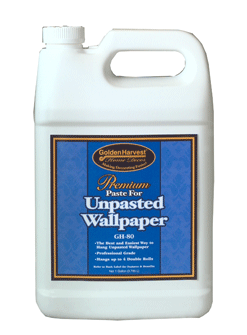 Enables wallpaper to adhere to wall.
Enables wallpaper to adhere to wall.- Water soluble, so cleans up with soap and water.
- Special formulas designed for boarders where vinyl to vinyl adhesion is needed.
- Some have tinting agent that ensures complete coverage.
- Be sure to check the kind of paper before you buy paste. Some coverings require wheat paste, while others use liquid vinyl adhesive or a vinyl paste.
Belt Sander
 Sands using a continuous belt or abrasive material.
Sands using a continuous belt or abrasive material.- Used for aggressive removal of stock.
- Uses two pulleys, a drive pulley that drives the belt and an idler pulley that guides it.
- Two handles allow the user to push or pull the machine with little effort.
- Comes in sizes of 2-1/2” to 4” wide belts; 3” wide is the most common size.
- Some models have dust collection systems to help control the dust from sanding.
- Most models have an adjustment feature that automatically maintains the belt in the center of the pulley during operation to eliminate belts that wander off the pulleys.
- When using, take care not to gouge or ripple a soft wood surface. This sander can remove material rapidly.
- Use open-coat sandpaper as it is less likely to clog.
Sanding Disc
 Most often used with disc sanders and random orbit sanders.
Most often used with disc sanders and random orbit sanders.- Available in a variety of grits and weights.
- One style is PSA. PSA stands for pressure sensitive adhesive, so sandpapers of this type have a sticky backing. Generally, this type is used for sanding jobs where you will use the sandpaper until it is worn out. Not for tasks where you will be changing sandpaper frequently.
- Another style is hook and loop, which attaches to the sander like Velcro. It is removable and good for jobs that require frequent changing of the sandpaper.
- Holes in the sandpaper enable dust extraction to reduce buildup of dust on the abrasive.
Sanding Sheets
 Most often used with orbital sanders and other types of profile and finishing sanders.
Most often used with orbital sanders and other types of profile and finishing sanders.- Square or triangular in shape, depending on the type of sander they are to be used with.
- Available in a variety of grits and weights.
- One style is PSA. PSA stands for pressure sensitive adhesive, so sandpapers of this type have a sticky backing. Generally, this type is used for sanding jobs where you will use the sandpaper until it is worn out. Not for tasks where you will be changing sandpaper frequently.
- Another style is hook and loop, which attaches to the sander like Velcro. It is removable and good for jobs that require frequent changing of the sandpaper.
- Another, more economical alternative to PSA and hook and loop sandpaper are sanders that use clamps to hold the sandpaper to the sanding pad. In this style, standard sheet sandpaper can be used. A paper punch tool is usually included with the sander to poke the holes in the paper to aid in dust extraction.
Auger
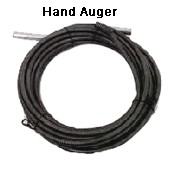 Also known as a snake.
Also known as a snake.- Consists of a coiled spiral cable, usually 1/4î thick and of varying lengths.
- The most basic type has a z-shaped handle used to crank the cable as it snakes through the drain.
- Another type uses a funnel-shaped container to store the cable and then to spin it as it works its way through the drain.
- Professionals use an auger attached to a drill or other device that spins the cable. Usually these versions can maneuver a much longer cable.
Chain Pipe Wrench
 Offers easy handling in close quarters on round, square or irregular shapes without crushing the object.
Offers easy handling in close quarters on round, square or irregular shapes without crushing the object.- Consists of a forged-steel handle attached to a length of heavy sprocket chain. The chain wraps around a length of pipe and engages the sprockets in notches on the back of the handle. Sharp teeth on the face of the handle bite into pipe while the chain holds the pipe against the teeth to prevent slipping.
- Turns pipe in either direction and can be used like a ratchet wrench. The handle can be loosened, shifted and turned again without removing the chain from around the pipe.
Strap Wrench
 Recommended for working with brass, aluminum, lead, soft metal or plastic pipe because it grips pipe without teeth and does not damage the surface.
Recommended for working with brass, aluminum, lead, soft metal or plastic pipe because it grips pipe without teeth and does not damage the surface.- Consists of a fabric strap, attached to a loop ring that is fastened in the curved head of a straight forged bar or handle. It is then pulled around the pipe, back through the loop and over the head.
- When the wrench is pulled tight, the strap grips the pipe.
Basin Wrench
 Also known as a faucet wrench or a crowfoot faucet wrench.
Also known as a faucet wrench or a crowfoot faucet wrench.- One type has fixed jaws opening at right angles to the shaft handle. It is primarily used to remove supply nuts and hose coupling nuts on faucet spray attachments under worktables, sinks and lavatories.
- The second type has spring tension pipe-gripping jaws that are reversible by flip-over on the end of drive shaft handle. It will grip pipe nipples, odd sized supply nuts and jam nuts in hard-to-reach spots.
Spud Wrench
 A generic name for many types of wrenches that have large, flat-sided jaws.
A generic name for many types of wrenches that have large, flat-sided jaws.- Good for general purpose plumbing use.
- The Adjustable type is an all-purpose model with notched jaws ideal for various sizes of nuts. It is the handiest and most common.
- The Fixed type works with large spud nuts under kitchen sinks.
- The 4-in-1 is similar to the fixed type and is use for turning locknuts on the toilet tank, basket strainers and spuds.
- The Closet type is designed for toilet tanks and bowls.
- The Internal type holds the sink strainer basket in place while you tighten the locknut below. It can also remove or install closet spuds, pop-up plugs, and strainers.
Drywall Saw
- Resembles a kitchen knife in design and is used to cut drywall and plasterboard in the same fashion as a keyhole saw, such as for sawing holes for electric outlets and switchplates.
- The saw is self-starting with a sharp point for plunge cuts.
- It may also have induction teeth for longer life without sharpening.




